Related Research Articles
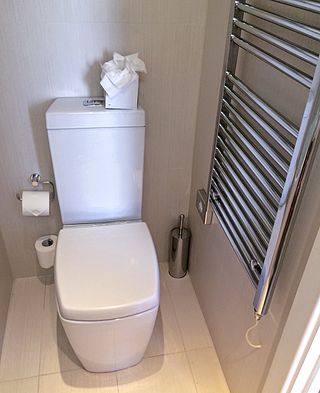
A flush toilet is a toilet that disposes of human waste by using the force of water to flush it through a drainpipe to another location for treatment, either nearby or at a communal facility, thus maintaining a separation between humans and their waste. Flush toilets can be designed for sitting or squatting, in the case of squat toilets. Most modern sewage treatment systems are also designed to process specially designed toilet paper. The opposite of a flush toilet is a dry toilet, which uses no water for flushing.
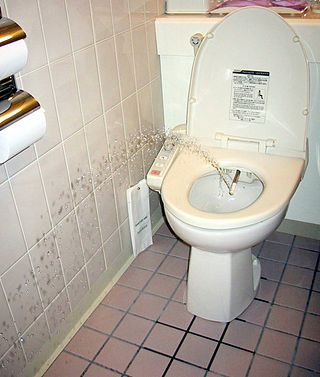
Toilets in Japan are sometimes designed more elaborately than toilets commonly seen in other developed nations. European countries often have a toilet and a bidet separate whilst Japan combines an electronic bidet with the toilet. The current state of the art for Western-style toilets in Japan is the bidet toilet, which as of March 2016 is installed in 81% of Japanese households. In Japan, these bidets are commonly called washlets, a brand name of Toto Ltd., and they may include many advanced features rarely seen outside of Asia. The basic feature set commonly found on washlets consists of anal hygiene, bidet washing, seat warming, and deodorization.
A ballcock is a mechanism or machine for filling water tanks, such as those found in flush toilets, while avoiding overflow and backflow. The modern ballcock was invented by José Antonio de Alzate y Ramírez, a Mexican priest and scientist, who described the device in 1790 in the Gaceta de Literatura Méxicana. The ballcock device was patented in 1797 for use in steam engines by Edmund Cartwright.

A cistern is a waterproof receptacle for holding liquids, usually water. Cisterns are often built to catch and store rainwater. Cisterns are distinguished from wells by their waterproof linings. Modern cisterns range in capacity from a few litres to thousands of cubic metres, effectively forming covered reservoirs.
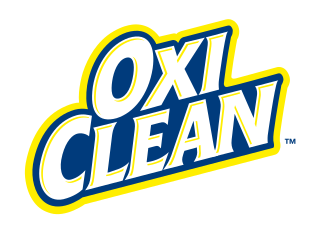
OxiClean is an American brand of household cleaners, including OxiClean Versatile Stain Remover, which is a laundry additive, spot stain remover, and household cleaner marketed by Church & Dwight. It was formerly owned by Orange Glo International from its introduction in 1997 until it was acquired in 2006.

A wet wipe, also known as a wet towel or a moist towelette, disposable wipe, disinfecting wipe, or a baby wipe is a small to medium-sized moistened piece of plastic or cloth that either comes folded and individually wrapped for convenience or, in the case of dispensers, as a large roll with individual wipes that can be torn off. Wet wipes are used for cleaning purposes like personal hygiene and household cleaning; each is a separate product depending on the chemicals added and medical or office cleaning wipes are not intended for skin hygiene.

Ajax is a brand of household cleaning products and detergents made by Colgate-Palmolive. The brand is also licensed by Colgate-Palmolive in the United States, Canada and Puerto Rico.
Vanish is an American brand of toilet bowl cleaner produced by S. C. Johnson in North America. They obtained the brand through the purchase of The Drackett Company in 1992.
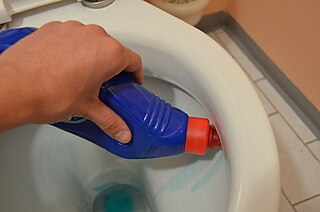
Toilet cleaners are chemical solutions designed specifically for cleaning a toilet bowl, usually in conjunction with a toilet brush.
Sani-Flush was an American brand of crystal toilet bowl cleaner formerly produced by Reckitt Benckiser. Its main ingredient was sodium bisulfate; it also contained sodium carbonate as well as sodium lauryl sulfate, talc, sodium chloride, fragrance and dye.

Cleaning agents or hard-surface cleaners are substances used to remove dirt, including dust, stains, foul odors, and clutter on surfaces. Purposes of cleaning agents include health, beauty, removing offensive odor, and avoiding the spread of dirt and contaminants to oneself and others. Some cleaning agents can kill bacteria and clean at the same time. Others, called degreasers, contain organic solvents to help dissolve oils and fats.
A low-flush toilet is a flush toilet that uses significantly less water than traditional high-flow toilets. Before the early 1990s in the United States, standard flush toilets typically required at least 3.5 gallons per flush and they used float valves that often leaked, increasing their total water use. In the early 1990s, because of concerns about water shortages, and because of improvements in toilet technology, some states and then the federal government began to develop water-efficiency standards for appliances, including toilets, mandating that new toilets use less water. The first standards required low-flow toilets of 1.6 gallons per flush. Further improvements in the technology to overcome concerns about the initial poor performance of early models have further cut the water use of toilets and while federal standards stagnate at 1.6 gallons per flush, certain states' standards toughened up to require that new toilets use no more than 1.28 gallons per flush, while working far better than older models. Low-flush toilets include single-flush models and dual-flush toilets, which typically use 1.6 US gallons per flush for the full flush and 1.28 US gallons or less for a reduced flush.

Block Drug Company was a pharmaceutical company based in Jersey City, New Jersey, United States, that specialized in dental care products. Its most popular products included Polident denture cleanser, Poli-Grip denture adhesive, Dentu-Creme denture toothpaste, Nytol sleeping pill, Tegrin medicated shampoo for psoriasis, Lava hand soaps, Beano and Phazyme anti-gas products, Balmex diaper rash ointments, and Sensodyne desensitizing toothpaste.

A flushometer is a metal water-diverter that uses an inline handle to flush tankless toilets or urinals. It was invented by William Elvis Sloan and is a product of the Sloan Valve Company.
Niagara Conservation is a manufacturing company based in Fort Worth, Texas best known for its plumbing products and its water conservation efforts. Niagara Conservation also manufactures lighting fixtures, light bulbs, caulks, sealants, and weatherization products.
Ty-D-Bol is an American brand of toilet cleaner that was introduced in 1958. In its original format, the product is a blue cleanser/disinfectant liquid released into the toilet tank from an automatic dispenser.
Ekam Eco Solutions is an Indian startup company that markets products related to ecological sanitation and sustainable living. The company is best known for its Zerodor waterless urinal technology and CARE Natural Housekeeping & Home Care Solutions.
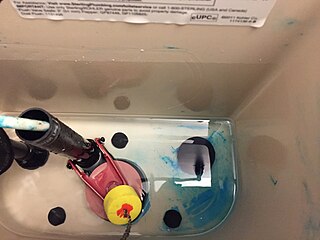
In-tank toilet cleaners are tablets or cartridges that add chemicals to toilet tank water to reduce toilet bowl stains. They are commonly used to prevent toilet bowl stains from calcium, limescale, mold, etc. Most contain chlorine bleach as its main active ingredient, however some may use other main active ingredients.
References
- ↑ US trademark #73176664, "2000 FLUSHES", CLEANER FOR TOILET BOWLS filed June 30, 1978
- ↑ "2000 Flushes History | Toilet Bowl Cleaners & Toilet Detergents". 2000 Flushes. Retrieved 2014-07-27.
- ↑ New 2000 Flushes automatic bowl cleaner (Boscov's advertisement), Reading Eagle - Nov 11, 1978
- ↑ Newspaper advertisement, "I quit the job I hate most", The Pittsburgh Press - Apr 11, 1979
- ↑ Dougherty, Philip H. (1982-03-01). "Advertising - New Bowl Cleaners On the Way". NY Times. Retrieved 2014-07-27.
- ↑ Goldblatt, Dan (September 7, 1994). "New Jersey's most private public company". Northern Business. p. 48.
- ↑ Lurie, Maxine N.; Lurie, Maxine; Mappen, Marc (2004). Encyclopedia of New Jersey. ISBN 9780813533254 . Retrieved 2014-07-27.
- ↑ "History of Block Drug Company". Funding Universe. Retrieved 2014-07-27.
- ↑ "2000 Flushes History | Toilet Bowl Cleaners & Toilet Detergents". 2000flushesbrand.com. Retrieved 2014-07-27.
- ↑ "Toilet Fixtures Introduction". Alliance for Water Efficiency. 1994-01-01. Retrieved 2014-07-27.
- ↑ "Resources > Product Information > Toilet Fixtures > Flappers & Flush Valve Seals". California Urban Water Conservation Council. Retrieved 2014-07-27.
- ↑ TOILET FLAPPERS: The Weak Link of Water Conservation, John Koeller, P.E, revised July 21, 2004
- ↑ Toilet flappers - The former weak link of water conservation Archived 2016-03-03 at the Wayback Machine , Koeller, April 2008
- ↑ "WD-40 Company to Acquire Global Household Brands (press release)". 2001-04-30. Archived from the original on 2016-03-05. Retrieved 2014-07-27.
- ↑ "Learn What WD-40 Stands For and More About Our Company History". WD40 Company. Archived from the original on 2015-04-18. Retrieved 2014-07-27.
- ↑ Kim, Hank (1998-05-18). "Global Household Brands Shops Bloom's X-14 Cleaner". Adweek. Retrieved 2014-07-27.
- ↑ Christine Church. House Cat: How to Keep Your Indoor Cat Sane and Sound . Wiley. p. 29 . Retrieved 2014-07-27.